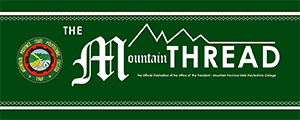STATUS OF THE MACRO FLORAL RESOURCES IN THE RICE TERRACES WATERSHEDS
Lubin Jr. G.G., Lasangen, W.T., Claudio, G.B., and Lawagey, D.L.
ABSTRACT
The study was undertaken to generate an understanding of the macro floral resources in the rice terraces watershed integrating participatory approach in the process. Specifically, the study aimed to characterize and assess the vegetation profile of the rice terraces watersheds in terms of species composition and conservation status, determine the species richness and diversity of the macro flora, identify economically and socio-culturally important plants, and determine the watershed indigenous conservation practices of farmers.
Findings showed that the Lubon rice terraces watershed is composed of 20 tree species, 20 shrub species and 55 species of lower forms of plants. These species belong to 9 genera and 9 families of trees, 10 genera and 11 families of shrubs and 28 genera and 18 families of lower forms of plants. The Bay-yo rice terraces had 35 tree species, 19 shrub species and 42 species of lower forms of plants that belong to 9 genera and 8 families of trees, 10 genera and 7 families of shrubs, and 22 genera and 14 families of lower forms of plants.
Molave, Tibangran and Degway were listed among the threatened species of plants in the Philippines. Molave was listed under Category B or endangered species while Tibangran and Degway were listed under Category C or vulnerable species.
Benguet pine is the most numerous, the most commonly observed, the biggest, and the most dominant tree in the Lubon rice terraces waterhed. For the shrubs, the most numerous for the private woodlot/communal forest are atilba. The most commonly observed were atilba and buladan, and the biggest is sagingsing. Buladan has the highest importance value for the private woodlot/communal. For the high peak forest, the most numerous and the most commonly observed was buladan, the biggest and the most dominant was Sapotan. As a whole, Buladan is the most important shrub species.
In Bay-yo rice terraces watershed, Gamo is the most evenly distributed and Tabangew is the most numerous, the biggest, and the most dominant tree in the communal forest.
In the high peak forest, the species were more or less evenly distributed Ludlod was the most numerous and Gamo was the biggest tree and the most dominant. Overall, Tabangew was the most dominant tree species. The most numerous shrubs for the communal forest are Arangaang, the most evenly distributed were Arangaang and Anatil, which scored the same, and the biggest is gotmo. For the high peak forest, buladan was the most numerous, the most evenly distributed, the biggest and the most dominant. The most dominant shrub is Arangaang for the communal forest and Buladan for high peak forest.
The rice terraces watershed has higher species richness compared to the private and communal forest located at lower elevations. The macro floral diversity index of the high peak and private/communal forest at the Lubon rice terraces watershed are both qualitatively interpreted as medium diversity for the tree components and high diversity for the shrub components. The Bay-yo rice terraces watershed tree component in both high peak and communal forest was high diversity. The shrub component at the communal forest has medium diversity but had high diversity at the high peak forest.
The tree species specifically Benguet pine is economically regarded for timber, construction and lumber for sale, by 100% of the respondents, which conforms to its being the most numerous, biggest in dbh and other attributes. The other tree species are likewise economically important like the bagtingen, playen and tikem. Socio-culturally, these trees are also regarded for fuelwood, fence, and farmtool handle, as among the highest in ranking by the respondents. The other species are also regarded for these uses but of lower percentage ranking than the mentioned species. For the shrub, grass and fern species, they also have their corresponding economic and socio-cultural importance. As a whole, the respondents had higher regard for the socio-cultural uses of these other watershed species than for their economic use except for Bika and Anes used economically for furniture. Most fern species on the other hand are economically used for tea and socio-culturally important as hendgerow for sakti and pako.
For the conservation practices, the customary laws are strongly implemented. Beliefs and folklores may enhance the implementation of customary laws for watershed conservation.





















